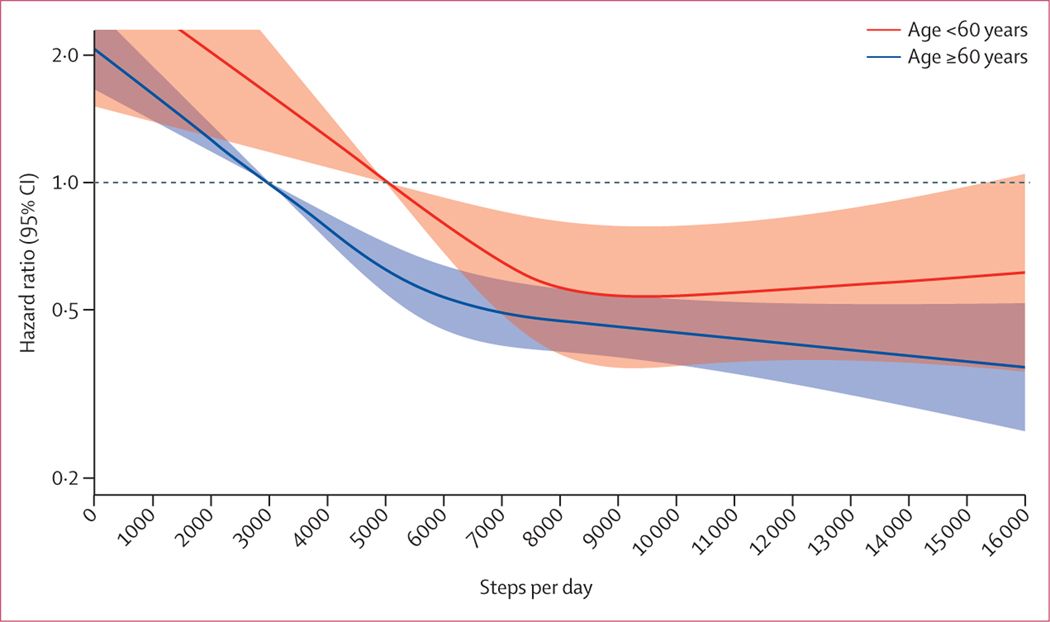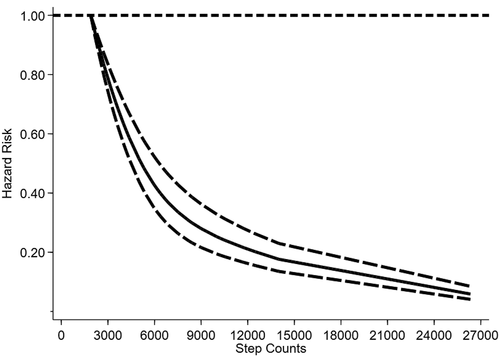How to increase your daily step count: Step 1 - 6000

Lately some of my patients have been asking me about how to increase their daily steps, and along with that, they have been frustrated that they can’t hit 10 000 steps. To some it seems impossible and they go through periods of giving up on hitting it because they think that if they can’t hit it then why try.
Today I am going to be going over how many steps you should be getting per day (spoiler alert: it doesn’t have to be 10 000 steps per day), how many the general population is getting on average, the potential benefits, and some quick ideas on how to increase your step count.
How many steps are people getting?
When looking at the average number of global steps, the number is around 5000 steps/day,1,2 which is MUCH lower than the common recommendation of 10 000. A quick side note, 10 000 steps per day is not mentioned in the WHO, Canadian, or American physical activity guidelines, and is lacking evidence to support it.3-6 For my North American readers, looking at the average steps per day for all of North America, it is right around 5000. Us Canadians seem to do it slightly better than our neighbours to the south, with the USA hitting about 4774 steps. A large influence on this number seems to be the walkability of the city, with more walkable cities not only producing more steps, but also resulting in a smaller difference between the lowest and highest number of steps.2 Even though this is half of the common recommendation of 10 000 steps per day, the American physical activity guidelines do recommend the baseline amount of steps per day to be 5000.5 So when looking at the average steps compared to the minimum recommendation from the US, North Americans are at least hitting that.
How many steps should I get!?
Here is where the great news starts to roll in! In order to see benefits from taking those steps, you don’t have to hit some magical threshold, any increase from a lower step count to a higher step count is associated with significant decreases in all-cause mortality!1,3 The changes are actually proportionally larger when increasing from a lower step count, and start to reach a bit of a plateau around 8-10k steps, with differences among age groups.1,3 Increasing from 2000 to 4000 was associated with very large decreases in all-cause mortality, and the increase from 2000 to about 6500 seems to be where the most change takes place.1,3 I hope you just took a large sigh of relief and that you don’t feel stressed about trying to hit that 10 000 mark. This evidence is showing that getting around 6000 steps per day is a good target and is associated with beneficial outcomes. The graphs below show how the increases from a low step count to a moderate one produce larger changes.


As you probably noticed, these graphs show that there is still benefit from going above 6000 steps, so it is beneficial to continue to increase your steps beyond that.1,3 When further breaking things down by age group, individuals over 60 seem to level off around 8000 steps, and those under 60 around 9000.3 This doesn’t mean going beyond that is bad, but the efforts for increasing steps past that may be better spent - in terms of optimally spending your time - participating in other physical activities that are guideline recommended such as strengthening or moderate-vigorous physical activity. However, you can really do whatever you want to do and whatever brings you joy, since having fun and continuing with activity is very important.
Step count hacks
Awesome, now we have a good understanding of the data and how many steps per day you will benefit from, but how do you go about increasing your steps, besides the obvious task of going for walks? Creating small changes that don’t disrupt your day too much may be beneficial and these could be things such as: using the stairs instead of an elevator or escalator, parking further away in parking lots, lightly walking while answering emails from a mobile device or reading, or walking on a treadmill while watching your favourite tv show. These kinds of activities are fairly time efficient and do not add much time to your daily tasks.
Other activities that you can also incorporate, which may take a small extra amount of time, would be things such as: getting off of your bus one stop early, replacing very short drives with walking or biking to your destination, going for a 5 minute walk between episodes while you are bingeing netflix, adding in exercise snacks such as 3 sets of 20s stair sprints - these have the added benefit of increasing your cardiovascular fitness!7 All of these activities should take less than 10 minutes, making them easier to fit into your day
To sum everything up, increasing your steps by even a small amount, especially if you are getting very few steps per day, may have some large benefits. A good starting goal can be to slowly increase your steps to 6000 per day, which you may find to be much more achievable than 10 000. Incorporating walking into tasks that you would otherwise be sitting or standing during is an easy way to get some steps in, as well as making a small effort to walk slightly further distances during your daily tasks. Small exercise snacks can break up your day and give some good health benefits.
Any increase is better than no increase, so as always it’s time to go out there and move!
*This is an informational resource and not medical advice, please consult your healthcare practitioner for diagnosis, treatment, and guidance.
References
- Liu Y, Sun Z, Wang X, Chen T, Yang C. Dose-response association between the daily step count and all-cause mortality: A systematic review and meta-analysis. J Sports Sci. 2022 Jul 12:1-10. doi: 10.1080/02640414.2022.2099186. Epub ahead of print. PMID: 35819337.
- Althoff T, Sosič R, Hicks JL, King AC, Delp SL, Leskovec J. Large-scale physical activity data reveal worldwide activity inequality. Nature. 2017 Jul 20;547(7663):336-339. doi: 10.1038/nature23018. Epub 2017 Jul 10. PMID: 28693034; PMCID: PMC5774986.
- Paluch AE, Bajpai S, Bassett DR, Carnethon MR, Ekelund U, Evenson KR, Galuska DA, Jefferis BJ, Kraus WE, Lee IM, Matthews CE, Omura JD, Patel AV, Pieper CF, Rees-Punia E, Dallmeier D, Klenk J, Whincup PH, Dooley EE, Pettee Gabriel K, Palta P, Pompeii LA, Chernofsky A, Larson MG, Vasan RS, Spartano N, Ballin M, Nordström P, Nordström A, Anderssen SA, Hansen BH, Cochrane JA, Dwyer T, Wang J, Ferrucci L, Liu F, Schrack J, Urbanek J, Saint-Maurice PF, Yamamoto N, Yoshitake Y, Newton RL Jr, Yang S, Shiroma EJ, Fulton JE; Steps for Health Collaborative. Daily steps and all-cause mortality: a meta-analysis of 15 international cohorts. Lancet Public Health. 2022 Mar;7(3):e219-e228. doi: 10.1016/S2468-2667(21)00302-9. PMID: 35247352; PMCID: PMC9289978.
- Bull FC, Al-Ansari SS, Biddle S, Borodulin K, Buman MP, Cardon G, Carty C, Chaput JP, Chastin S, Chou R, Dempsey PC, DiPietro L, Ekelund U, Firth J, Friedenreich CM, Garcia L, Gichu M, Jago R, Katzmarzyk PT, Lambert E, Leitzmann M, Milton K, Ortega FB, Ranasinghe C, Stamatakis E, Tiedemann A, Troiano RP, van der Ploeg HP, Wari V, Willumsen JF. World Health Organization 2020 guidelines on physical activity and sedentary behaviour. Br J Sports Med. 2020 Dec;54(24):1451-1462. doi: 10.1136/bjsports-2020-102955. PMID: 33239350; PMCID: PMC7719906.
- https://health.gov/sites/default/files/2019-09/Physical_Activity_Guidelines_2nd_edition.pdf
- https://csepguidelines.ca/guidelines/adults-18-64/
- Jenkins EM, Nairn LN, Skelly LE, Little JP, Gibala MJ. Do stair climbing exercise "snacks" improve cardiorespiratory fitness? Appl Physiol Nutr Metab. 2019 Jun;44(6):681-684. doi: 10.1139/apnm-2018-0675. Epub 2019 Jan 16. PMID: 30649897.

Member discussion